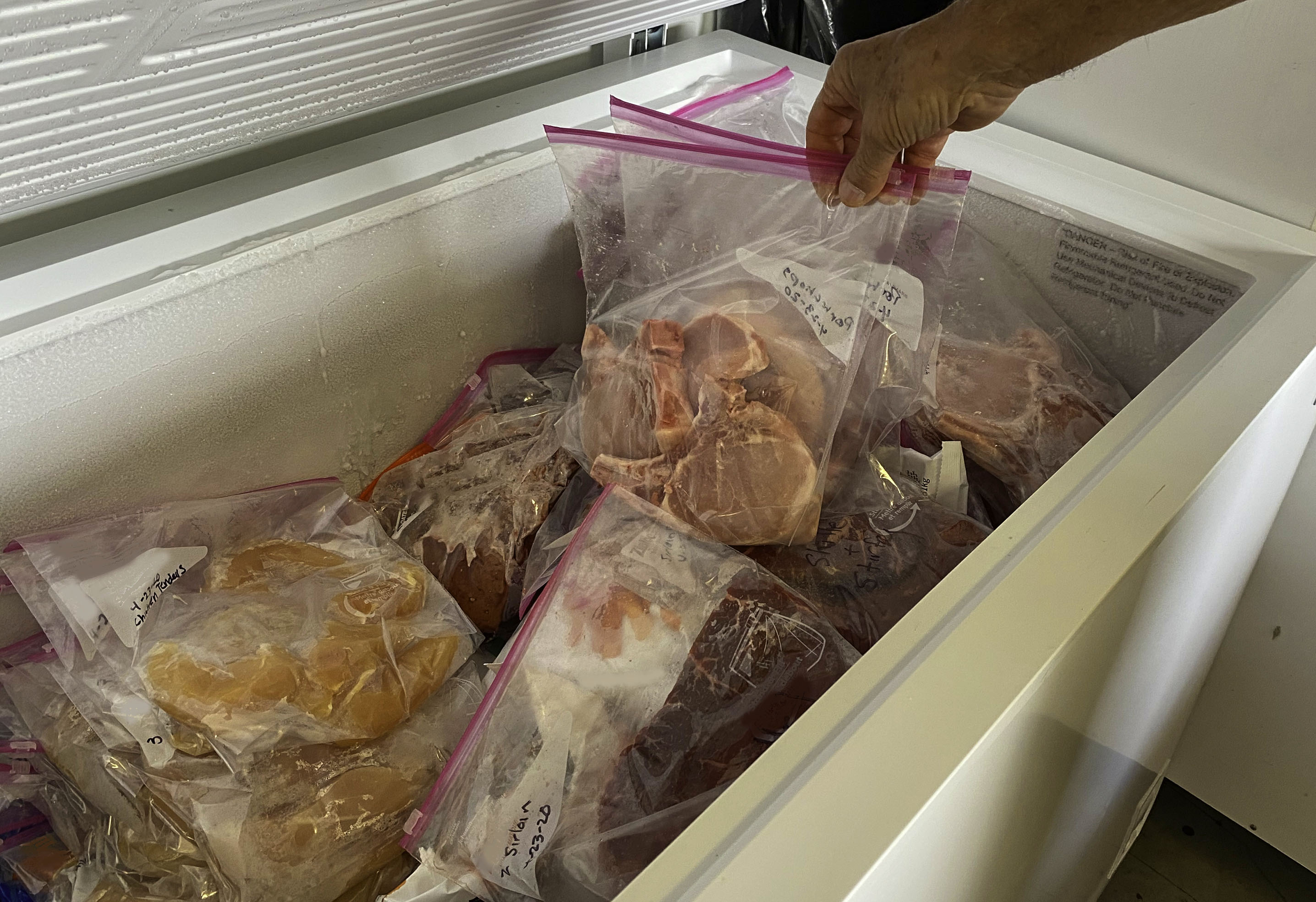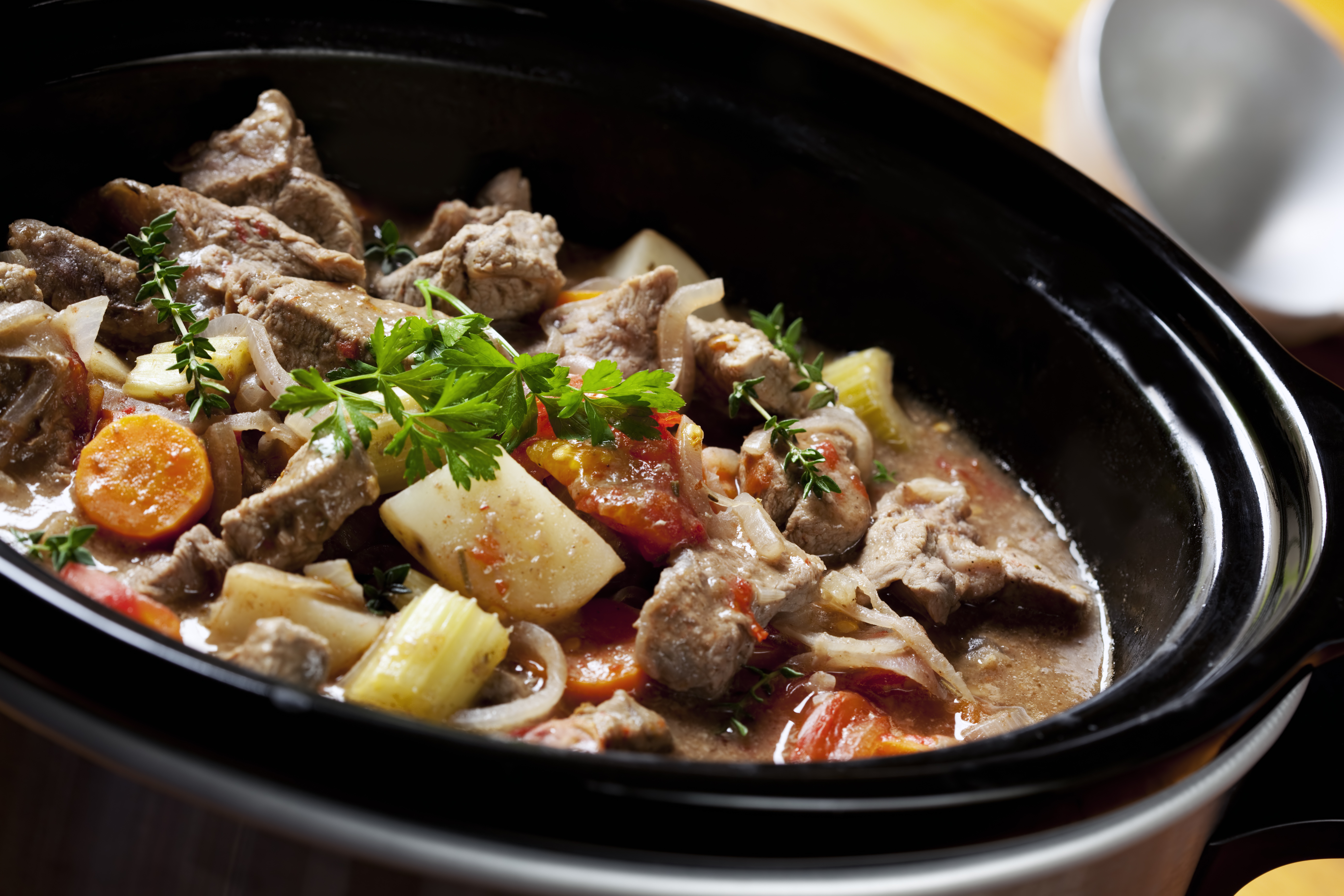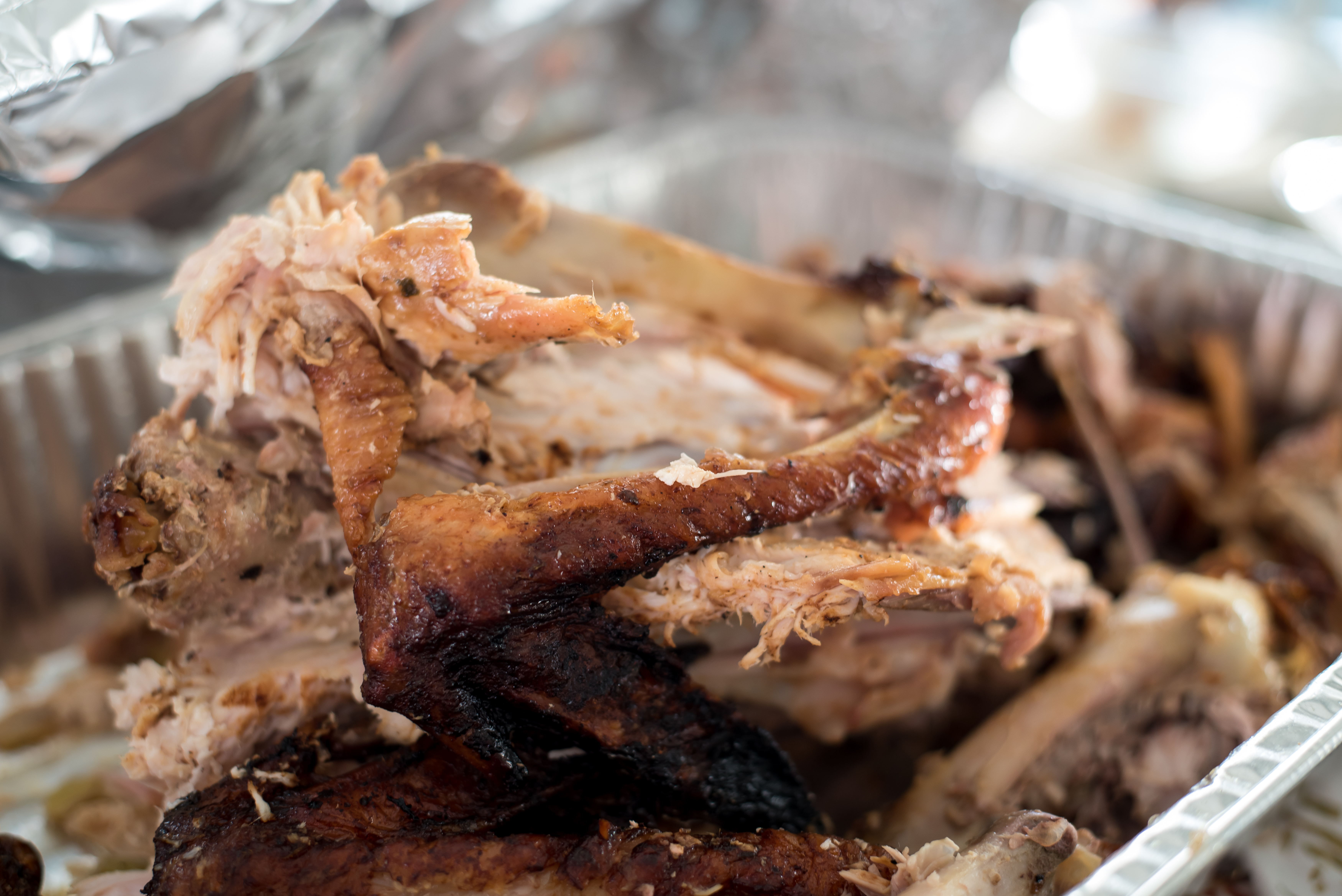
Freezing and Food Safety

Foods in the freezer — are they safe? Every year, thousands of callers to the USDA Meat and Poultry Hotline aren't sure about the safety of items stored in their own home freezers. The confusion seems to be based on the fact that few people understand how freezing protects food. Here is some information on how to freeze food safely and how long to keep it.
You can freeze almost any food. Some exceptions are canned food or eggs in shells. However, once the food (such as a ham) is out of the can, you may freeze it.
Being able to freeze food and being pleased with the quality after defrosting are two different things. Some foods simply don't freeze well. Examples are mayonnaise, cream sauce and lettuce. Raw meat and poultry maintain their quality longer than their cooked counterparts because moisture is lost during cooking.
Food stored constantly at 0 °F will always be safe. Only the quality suffers with lengthy freezer storage. Freezing keeps food safe by slowing the movement of molecules, causing microbes to enter a dormant stage. Freezing preserves food for extended periods because it prevents the growth of microorganisms that cause both food spoilage and foodborne illness.
Freezing to 0 °F inactivates any microbes — bacteria, yeasts and molds — present in food. Once thawed, however, these microbes can again become active, multiplying under the right conditions to levels that can lead to foodborne illness. Since they will then grow at about the same rate as microorganisms on fresh food, you must handle thawed items as you would any perishable food.
Trichina and other parasites can be destroyed by sub-zero freezing temperatures. However, very strict government-supervised conditions must be met. Home freezing cannot be relied upon to destroy trichina. Thorough cooking, however, will destroy all parasites.
Freshness and quality at the time of freezing affect the condition of frozen foods. If frozen at peak quality, thawed foods emerge tasting better than foods frozen near the end of their useful life. So freeze items you won't use quickly sooner rather than later. Store all foods at 0° F or lower to retain vitamin content, color, flavor and texture.
Nutrient Retention
The freezing process itself does not destroy nutrients. In meat and poultry products, there is little change in nutrient value during freezer storage.
Enzymes
Enzyme activity can lead to the deterioration of food quality. Enzymes present in animals, vegetables, and fruit promote chemical reactions before and after harvest, such as ripening. Freezing only slows the enzyme activity that takes place in foods. It does not halt them.
Enzyme activity does not harm frozen meats or fish and is neutralized by the acids in frozen fruits. But most vegetables that freeze well are low acid and require brief, partial cooking to prevent deterioration. This is called "blanching." For successful freezing, blanch or partially cook vegetables in boiling water or in a microwave oven. Then rapidly chill the vegetables prior to freezing and storage. Consult a cookbook for timing.
Proper packaging helps maintain quality and prevent freezer burn. It is safe to freeze meat or poultry directly in its original packaging, however this type of wrap is permeable to air and quality may diminish over time. For prolonged storage, overwrap these packages as you would any food for long-term storage. It is not necessary to rinse meat and poultry. Freeze unopened vacuum packages as is. If you notice that a package has accidentally been torn or has opened while food is in the freezer, the food is still safe to use; merely overwrap or rewrap it.
Freezer burn does not make food unsafe, merely dry in spots. It appears as grayish-brown leathery spots and is caused by air coming in contact with the surface of the food. Cut freezer-burned portions away either before or after cooking the food. Heavily freezer-burned foods may have to be discarded for quality reasons.
Color changes can occur in frozen foods. The bright red color of meat as purchased usually turns dark or pale brown depending on its variety. This may be due to lack of oxygen, freezer burn or abnormally long storage.
Freezing doesn't usually cause color changes in poultry. However, the bones and the meat near them can become dark. Bone darkening results when pigment seeps through the porous bones of young poultry into the surrounding tissues when the poultry meat is frozen and thawed.
The dulling of color in frozen vegetables and cooked foods is usually the result of excessive drying due to improper packaging or over-lengthy storage.
Freeze food as fast as possible to maintain its quality. Rapid freezing prevents undesirable large ice crystals from forming throughout the product because the molecules don't have time to form into the characteristic six-sided snowflake. Slow freezing creates large, disruptive ice crystals. During thawing, they damage the cells and dissolve emulsions. This causes meat to "drip" and lose juiciness. Emulsions such as mayonnaise or cream will separate and appear curdled.
Ideally, a food 2-inches thick should freeze completely in about 2 hours. If your home freezer has a "quick-freeze" shelf, use it. Never stack packages to be frozen. Instead, spread them out in one layer on various shelves, stacking them only after frozen solid.
If a refrigerator freezing compartment can't maintain zero degrees or if the door is opened frequently, use it for short-term food storage. Eat those foods as soon as possible for best quality. Use a free-standing freezer set at 0 °F or below for long-term storage of frozen foods. Keep an appliance thermometer in your freezing compartment or freezer to check the temperature. This is important if you experience power-out or mechanical problems. The temperature in the refrigerator should be set at 40 °F or below. Check the refrigerator temperature with an appliance thermometer.
Because freezing keeps food safe almost indefinitely, recommended storage times are for quality only. Refer to the freezer storage chart at the end of this document, which lists optimum freezing times for best quality.
If a food is not listed on the chart, you may determine its quality after thawing. First check the odor. Some foods will develop a rancid or off odor when frozen too long and should be discarded. Some may not look picture perfect or be of high enough quality to serve alone but may be edible; use them to make soups or stews.
Never thaw foods in a garage, basement, car, dishwasher or plastic garbage bag; out on the kitchen counter, outdoors or on the porch. These methods can leave your foods unsafe to eat.
There are three safe ways to thaw food: in the refrigerator, in cold water, or in the microwave. It's best to plan ahead for slow, safe thawing in the refrigerator. Small items may defrost overnight; most foods require a day or two. And large items like turkeys may take longer, approximately one day for each 5 pounds of weight.
For faster thawing, place food in a leak proof plastic bag and immerse it in cold water. (If the bag leaks, bacteria from the air or surrounding environment could be introduced into the food. Tissues can also absorb water like a sponge, resulting in a watery product.) Check the water frequently to be sure it stays cold. Change the water every 30 minutes. After thawing, cook immediately.
When microwave-defrosting food, plan to cook it immediately after thawing because some areas of the food may become warm and begin to cook during microwaving.
Once food is thawed in the refrigerator, it is safe to refreeze it without cooking, although there may be a loss of quality due to the moisture lost through thawing. After cooking raw foods which were previously frozen, it is safe to freeze the cooked foods. If previously cooked foods are thawed in the refrigerator, you may refreeze the unused portion. Freeze leftovers within 3-4 days. Do not refreeze any foods left outside the refrigerator longer than 2 hours; 1 hour in temperatures above 90 °F.
If you purchase previously frozen meat, poultry or fish at a retail store, you can refreeze if it has been handled properly.
Raw or cooked meat, poultry or casseroles can be cooked or reheated from the frozen state. However, it will take approximately one and a half times as long to cook. Remember to discard any wrapping or absorbent paper from meat or poultry.
When cooking whole frozen poultry, remove the giblet pack from the cavity as soon as you can loosen it. Cook the giblets separately. Read the label on USDA-inspected frozen meat and poultry products. Some, such as pre-stuffed whole birds, MUST be cooked from the frozen state to ensure a safely cooked product.
The inspection mark on the packaging tells you the product was prepared in a USDA or State-inspected plant under controlled conditions. Follow the package directions for thawing, reheating, and storing.
If there is a power outage, the freezer fails, or if the freezer door has been left ajar by mistake, the food may still be safe to use if ice crystals remain. If the freezer has failed and a repairman is on the way, or it appears the power will be on soon, don't open the freezer door. If the freezer door was left ajar and the freezer continued to keep the food cold, the food should stay safe.
A freezer full of food will usually keep about 2 days if the door is kept shut; a half-full freezer will last about a day. The freezing compartment in a refrigerator may not keep foods frozen as long. If the freezer is not full, quickly group packages together so they will retain the cold more effectively. Separate meat and poultry items from other foods so if they begin to thaw, their juices won't drip onto other foods.
When the power is off, you may want to put dry ice, block ice, or bags of ice in the freezer or transfer foods to a friend's freezer until power is restored. Use an appliance thermometer to monitor the temperature.
To determine the safety of foods when the power goes on, check their condition and temperature. If food is partly frozen, still has ice crystals, or is as cold as if it were in a refrigerator (40 °F), it is safe to refreeze or use. It's not necessary to cook raw foods before refreezing. Discard foods that have been warmer than 40 °F for more than 2 hours. Discard any foods that have been contaminated by raw meat juices. Dispose of soft or melted ice cream for quality's sake.
When it is freezing outside and there is snow on the ground, the outdoors seems like a good place to keep food until the power comes on; however, frozen food can thaw if it is exposed to the sun's rays even when the temperature is very cold. Refrigerated food may become too warm and foodborne bacteria could grow. The outside temperature could vary hour by hour and the temperature outside will not protect refrigerated and frozen food. Additionally, perishable items could be exposed to unsanitary conditions or to animals. Animals may harbor bacteria or disease; never consume food that has come in contact with an animal.
Cans frozen accidentally, such as those left in a car or basement in sub-zero temperatures, can present health problems. If the cans are merely swollen — and you are sure the swelling was caused by freezing — the cans may still be usable. Let the can thaw in the refrigerator before opening. If the product doesn't look and/or smell normal, throw it out. DO NOT TASTE IT! If the seams have rusted or burst, throw the cans out immediately, wrapping the burst can in plastic and disposing the food where no one, including animals can get it.
Shell eggs should not be frozen. If an egg accidentally freezes and the shell cracked during freezing, discard the egg. Keep any uncracked eggs frozen until needed; then thaw in the refrigerator. These can be hard cooked successfully but other uses may be limited. That's because freezing causes the yolk to become thick and syrupy so it will not flow like an unfrozen yolk or blend very well with the egg white or other ingredients.
Freezer Storage Chart (0 °F)
Note: Freezer storage is for quality only. Frozen foods remain safe indefinitely.
| Item | Months |
|---|---|
| Bacon and Sausage | 1 to 2 |
| Casseroles | 2 to 3 |
| Egg whites or egg substitutes | 12 |
| Frozen Dinners and Entrees | 3 to 4 |
| Gravy, meat or poultry | 2 to 3 |
| Ham, Hotdogs and Lunchmeats | 1 to 2 |
| Meat, uncooked roasts | 4 to 12 |
| Meat, uncooked steaks or chops | 4 to 12 |
| Meat, uncooked ground | 3 to 4 |
| Meat, cooked | 2 to 3 |
| Poultry, uncooked whole | 12 |
| Poultry, uncooked parts | 9 |
| Poultry, uncooked giblets | 3 to 4 |
| Poultry, cooked | 4 |
| Soups and Stews | 2 to 3 |
| Wild game, uncooked | 8 to 12 |



